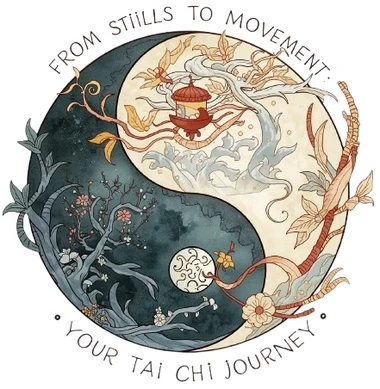Ever wondered why the 24-Step Simplified Tai Chi is the chosen form for over 90% of practitioners in places like Beijing? Is it just because it's easier, or is there a deeper, almost brilliant logic to its design that perfectly bridges tradition and modernity?
The 24-Step form wasn't created by mere simplification. It was a masterful redesign. Based on the traditional Yang style, it meticulously preserves the core essence—the "softness, slowness, circularity, and continuity"—while strategically distilling over 80 complex movements into just 24. Think of the repetitive "Cloud Hands" or "Single Whip" sequences; the 24-Step form keeps their spirit but eliminates the redundancy, making the core accessible without losing the soul.
Thebiān pái luó jí - arrangement logic is where the real magic lies.
First, it's a lesson in Technical Simplification and Core Retention. It’s not about dumbing down; it's about refining. The most representative and foundational techniques were cherry-picked to create a complete, coherent practice.
Second, the Progressive Pedagogy is flawless. The form is a carefully structured course. It starts with simple, forward-moving actions like "Commencement" and "Part the Wild Horse's Mane," allowing beginners to build confidence. Only then does it gently introduce more challenging elements like stepping back, side-stepping, and kicks. This "from easy to difficult" approach is a cornerstone of effective learning.
Third, it introduces a Comprehensive Design often missing in older forms. It breaks from the tradition of heavily favoring one side of the body by incorporating symmetrical practice on both left and right sides, as seen in the left and right "Repulse the Monkey." This ensures balanced physical development, a key tenet of modern fitness.
This intelligent design is precisely why its Promotional Significance has been so profound. Its moderate intensity and relatively short learning curve make it the perfect gateway to Tai Chi for National Fitness. It's a democratizing force, making a profound art available to all ages and fitness levels.
Furthermore, the form established crucial Teaching Standards. Created under the guidance of China's National Sports Bureau, it provided a unified standard for movements. The precise requirements for a posture like "White Crane Spreads Its Wings"—the empty stance, the parting hands, the eye direction—are clearly defined, ensuring quality and consistency in instruction worldwide.
And let's not mistake "simplified" for "superficial." This form masterfully embodies the Integration of Competition and Health Preservation. It retains the traditional martial intent and energy methods (like "Roll Back," "Press," and "Push") within its flowing sequence, making it suitable for both competitive performance and deep, personal wellness practice. Its structure has even influenced later competition forms like the 42-Step.
If you're looking to dive deeper into its history and philosophy, our blog offers a detailed companion piece: The Comprehensive Guide to 24-Step Simplified Tai Chi: History, Philosophy, and Practice.
So, what do you think? Was the creation of the 24-Step form the single most important factor in making Tai Chi a global phenomenon?
The 24-Step form wasn't created by mere simplification. It was a masterful redesign. Based on the traditional Yang style, it meticulously preserves the core essence—the "softness, slowness, circularity, and continuity"—while strategically distilling over 80 complex movements into just 24. Think of the repetitive "Cloud Hands" or "Single Whip" sequences; the 24-Step form keeps their spirit but eliminates the redundancy, making the core accessible without losing the soul.
Thebiān pái luó jí - arrangement logic is where the real magic lies.
First, it's a lesson in Technical Simplification and Core Retention. It’s not about dumbing down; it's about refining. The most representative and foundational techniques were cherry-picked to create a complete, coherent practice.
Second, the Progressive Pedagogy is flawless. The form is a carefully structured course. It starts with simple, forward-moving actions like "Commencement" and "Part the Wild Horse's Mane," allowing beginners to build confidence. Only then does it gently introduce more challenging elements like stepping back, side-stepping, and kicks. This "from easy to difficult" approach is a cornerstone of effective learning.
Third, it introduces a Comprehensive Design often missing in older forms. It breaks from the tradition of heavily favoring one side of the body by incorporating symmetrical practice on both left and right sides, as seen in the left and right "Repulse the Monkey." This ensures balanced physical development, a key tenet of modern fitness.
This intelligent design is precisely why its Promotional Significance has been so profound. Its moderate intensity and relatively short learning curve make it the perfect gateway to Tai Chi for National Fitness. It's a democratizing force, making a profound art available to all ages and fitness levels.
Furthermore, the form established crucial Teaching Standards. Created under the guidance of China's National Sports Bureau, it provided a unified standard for movements. The precise requirements for a posture like "White Crane Spreads Its Wings"—the empty stance, the parting hands, the eye direction—are clearly defined, ensuring quality and consistency in instruction worldwide.
And let's not mistake "simplified" for "superficial." This form masterfully embodies the Integration of Competition and Health Preservation. It retains the traditional martial intent and energy methods (like "Roll Back," "Press," and "Push") within its flowing sequence, making it suitable for both competitive performance and deep, personal wellness practice. Its structure has even influenced later competition forms like the 42-Step.
If you're looking to dive deeper into its history and philosophy, our blog offers a detailed companion piece: The Comprehensive Guide to 24-Step Simplified Tai Chi: History, Philosophy, and Practice.
So, what do you think? Was the creation of the 24-Step form the single most important factor in making Tai Chi a global phenomenon?
2
